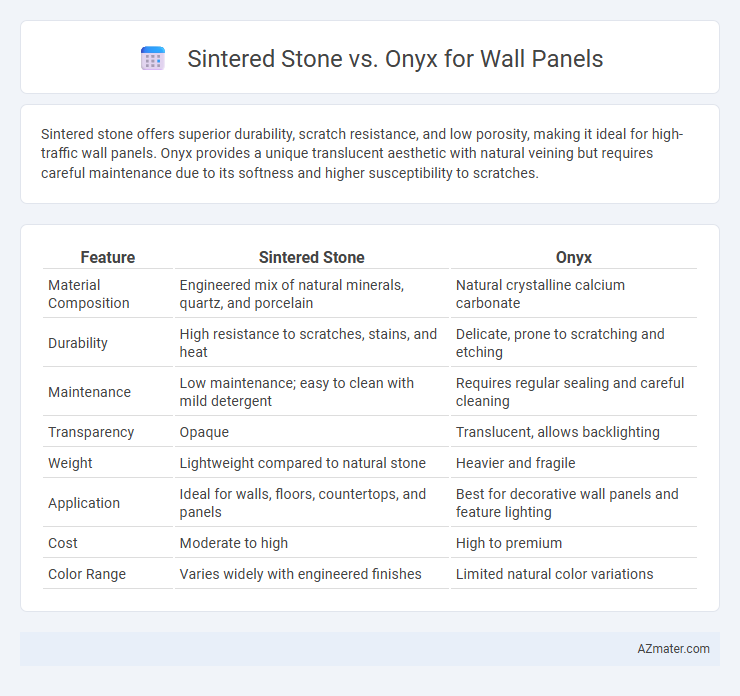Sintered stone offers superior durability, scratch resistance, and low porosity, making it ideal for high-traffic wall panels. Onyx provides a unique translucent aesthetic with natural veining but requires careful maintenance due to its softness and higher susceptibility to scratches.
Table of Comparison
| Feature | Sintered Stone | Onyx |
|---|---|---|
| Material Composition | Engineered mix of natural minerals, quartz, and porcelain | Natural crystalline calcium carbonate |
| Durability | High resistance to scratches, stains, and heat | Delicate, prone to scratching and etching |
| Maintenance | Low maintenance; easy to clean with mild detergent | Requires regular sealing and careful cleaning |
| Transparency | Opaque | Translucent, allows backlighting |
| Weight | Lightweight compared to natural stone | Heavier and fragile |
| Application | Ideal for walls, floors, countertops, and panels | Best for decorative wall panels and feature lighting |
| Cost | Moderate to high | High to premium |
| Color Range | Varies widely with engineered finishes | Limited natural color variations |
Introduction: Comparing Sintered Stone and Onyx for Wall Panels
Sintered stone offers superior durability, resistance to scratches, heat, and stains, making it ideal for high-traffic wall panels. Onyx features a translucent, luxurious appearance with unique veining, often used for decorative backlit installations that emphasize elegance. Both materials provide distinct aesthetic and functional benefits, but sintered stone excels in maintenance and longevity while onyx shines in refined visual impact.
Material Composition: Sintered Stone vs Onyx
Sintered stone is an engineered material composed of natural minerals such as quartz, feldspar, and glass, fused under high heat and pressure to create a dense, durable surface ideal for wall panels. Onyx, a natural stone formed primarily from calcium carbonate with translucent veining, offers a unique, luminescent aesthetic but is softer and more prone to scratching and etching compared to sintered stone. The high compressive strength and chemical resistance of sintered stone make it a practical choice for high-traffic or moisture-prone wall applications, whereas onyx requires more careful handling and maintenance to preserve its visual appeal.
Aesthetic Appeal: Visual Differences and Design Versatility
Sintered stone offers a matte or polished finish with consistent color and pattern, enhancing minimalist and contemporary wall panel designs. Onyx features translucent qualities and unique veining that create dramatic visual effects through backlighting, ideal for luxury and statement walls. The design versatility of sintered stone suits large, seamless installations, while onyx's natural variations lend exclusivity and depth to smaller, accent wall applications.
Durability and Strength: Which Material Lasts Longer?
Sintered stone offers exceptional durability and resistance to scratches, stains, and heat, making it ideal for long-lasting wall panels in high-traffic areas. Onyx, while visually striking with its translucent and luxurious appearance, is softer and more prone to scratches and impact damage, reducing its lifespan for wall cladding. Choosing sintered stone ensures superior strength and longevity, especially in environments requiring robust, maintenance-free surfaces.
Maintenance and Cleaning Requirements
Sintered stone offers high resistance to stains, scratches, and UV rays, making its maintenance simple with just mild soap and water, ideal for long-term cleanliness and durability on wall panels. Onyx, being more porous and delicate, requires careful sealing and periodic professional cleaning to prevent damage from moisture and staining, demanding more attentive upkeep. Choosing sintered stone minimizes cleaning frequency and risk of surface deterioration compared to the higher maintenance needs of onyx wall panels.
Installation Process and Challenges
Sintered stone wall panels require precise cutting tools and skilled labor due to their hardness and density, making installation more challenging but resulting in durable, low-maintenance surfaces. Onyx panels are softer and more fragile, demanding careful handling and specialized adhesives to prevent cracking during installation, often increasing labor time and costs. Both materials need professional expertise, but onyx panels require extra caution for alignment and support to maintain their translucent aesthetic.
Cost Comparison: Sintered Stone vs Onyx Paneling
Sintered stone offers a more cost-effective solution for wall paneling compared to onyx, with prices typically ranging from $40 to $70 per square foot, whereas onyx panels can cost between $75 and $150 per square foot due to their rarity and natural beauty. The durability and low maintenance of sintered stone make it an economical long-term investment, while onyx requires careful handling and sealing, increasing installation and upkeep expenses. Budget-conscious projects benefit from sintered stone's affordability paired with its aesthetic versatility, making it a preferred choice over the premium-priced onyx for wall applications.
Environmental Impact and Sustainability
Sintered stone for wall panels offers superior environmental benefits due to its use of natural raw materials and energy-efficient manufacturing processes that result in lower carbon emissions and higher durability, reducing replacement frequency. Onyx, while visually striking, poses sustainability challenges because it is a non-renewable mineral that requires significant mining, leading to higher environmental degradation and limited recyclability. Choosing sintered stone supports eco-conscious construction by minimizing waste and maximizing resource efficiency in sustainable building projects.
Common Applications in Interior Design
Sintered stone and onyx are popular choices for wall panels in interior design, each offering unique aesthetic and functional benefits. Sintered stone boasts durability and resistance to heat, stains, and scratches, making it ideal for high-traffic commercial spaces, kitchens, and bathrooms where longevity and low maintenance are crucial. Onyx provides a luxurious, translucent look often utilized in feature walls, backlit installations, and decorative accents to create a striking visual impact in residential lounges, hotels, and upscale retail environments.
Final Verdict: Choosing the Best Wall Panel Material
Sintered stone offers superior durability, scratch resistance, and low maintenance, making it ideal for high-traffic or moisture-prone wall panels. Onyx provides a unique translucency and luxurious aesthetic, perfect for decorative or ambient lighting applications where visual impact is paramount. The final verdict depends on balancing functional requirements with design goals; opt for sintered stone for practicality and longevity, or choose onyx to achieve striking, artistic wall installations.

Infographic: Sintered stone vs Onyx for Wall Panel
 azmater.com
azmater.com